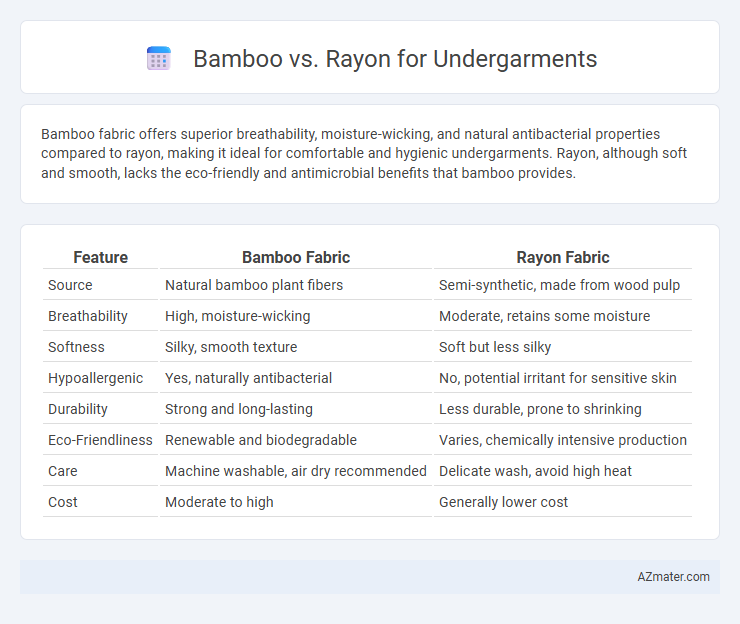Bamboo fabric offers superior breathability, moisture-wicking, and natural antibacterial properties compared to rayon, making it ideal for comfortable and hygienic undergarments. Rayon, although soft and smooth, lacks the eco-friendly and antimicrobial benefits that bamboo provides.
Table of Comparison
| Feature | Bamboo Fabric | Rayon Fabric |
|---|---|---|
| Source | Natural bamboo plant fibers | Semi-synthetic, made from wood pulp |
| Breathability | High, moisture-wicking | Moderate, retains some moisture |
| Softness | Silky, smooth texture | Soft but less silky |
| Hypoallergenic | Yes, naturally antibacterial | No, potential irritant for sensitive skin |
| Durability | Strong and long-lasting | Less durable, prone to shrinking |
| Eco-Friendliness | Renewable and biodegradable | Varies, chemically intensive production |
| Care | Machine washable, air dry recommended | Delicate wash, avoid high heat |
| Cost | Moderate to high | Generally lower cost |
Introduction to Bamboo and Rayon Fabrics
Bamboo fabric is derived from the pulp of bamboo grass, known for its natural antibacterial properties, breathability, and moisture-wicking abilities, making it ideal for undergarments requiring comfort and hygiene. Rayon, a semi-synthetic fiber made from regenerated cellulose typically sourced from wood pulp, offers a smooth texture and excellent drape while being more affordable and widely available than natural fabrics. Both fabrics are favored in undergarment production for their softness and versatility, but bamboo's eco-friendly cultivation and sustainability set it apart from traditional rayon manufacturing.
Origin and Production Processes
Bamboo fabric is derived from the cellulose of bamboo plants through a mechanical or chemical process, often involving eco-friendly methods that retain more natural fibers, making it sustainably sourced. Rayon for undergarments is produced by chemically processing cellulose from wood pulp or bamboo, then converting it into viscose fibers through extensive chemical treatment that can impact environmental sustainability. Bamboo fabric's natural origin contrasts with rayon's chemically intensive production, influencing their environmental footprint and fabric qualities in undergarment applications.
Environmental Impact Comparison
Bamboo undergarments offer significant environmental benefits due to bamboo's rapid growth and low water requirements, making it a highly sustainable raw material compared to rayon. Rayon production involves chemically intensive processes that can release toxic substances and cause water pollution, whereas bamboo fabric can be processed mechanically or with eco-friendly methods to reduce environmental harm. Choosing bamboo over traditional rayon contributes to lower carbon emissions, less deforestation, and minimal chemical waste, supporting more sustainable textile practices in undergarment manufacturing.
Comfort and Softness
Bamboo fabric offers superior comfort and softness for undergarments due to its natural breathability and moisture-wicking properties, which keep the skin dry and cool. Rayon, made from regenerated cellulose fibers, provides a smooth and silky texture but may lack the same level of moisture management and hypoallergenic benefits as bamboo. Consumers seeking all-day softness and enhanced comfort often prefer bamboo undergarments for their gentle feel and durability.
Moisture-Wicking and Breathability
Bamboo fabric offers superior moisture-wicking properties compared to rayon, efficiently drawing sweat away from the skin to keep undergarments dry and comfortable. Its natural breathability allows better air circulation, reducing heat buildup and enhancing overall comfort during extended wear. While rayon, derived from cellulose but chemically processed, may feel soft, it lacks the same level of moisture management and ventilation found in bamboo fibers.
Hypoallergenic Properties
Bamboo fabric is naturally hypoallergenic, making it ideal for sensitive skin and reducing the risk of irritation in undergarments. Rayon, especially when chemically processed, may cause allergic reactions or skin sensitivity in some individuals. Bamboo's antimicrobial and moisture-wicking qualities further enhance its suitability for hypoallergenic undergarments compared to conventional rayon.
Durability and Longevity
Bamboo fabric, known for its natural strength, offers excellent durability and maintains integrity through multiple washes due to its long cellulose fibers. Rayon, often derived from wood pulp like bamboo, typically has shorter fibers that result in reduced tensile strength and faster wear over time. Choosing bamboo-based undergarments ensures longer-lasting comfort and resilience compared to standard rayon alternatives.
Care and Maintenance Requirements
Bamboo undergarments require gentle washing with mild detergents and air drying to preserve softness and fiber integrity, while rayon fabrics need extra care due to their delicate cellulose fibers, often necessitating hand washing and avoiding high heat during drying. Both materials benefit from avoiding bleach and fabric softeners to prevent damage, but rayon is more prone to shrinkage and stretching over time. Proper care extends the lifespan of bamboo and rayon undies by maintaining their breathability and moisture-wicking properties.
Price and Accessibility
Bamboo undergarments generally cost more than rayon alternatives due to sustainable production processes and natural antibacterial properties. Rayon fabric, derived from wood pulp, offers a more affordable option widely available in mainstream retail stores. Consumers seeking budget-friendly undergarments often opt for rayon, while those prioritizing eco-friendly materials lean towards bamboo despite its higher price point.
Which is Better for Undergarments?
Bamboo fabric offers superior breathability, moisture-wicking, and natural antibacterial properties, making it an excellent choice for undergarments that prioritize comfort and hygiene. Rayon, though soft and smooth, is generally less durable and can lose shape faster due to its semi-synthetic nature derived from wood pulp. For undergarments, bamboo is better suited due to its eco-friendly production, enhanced softness, and longer-lasting wearability.

Infographic: Bamboo vs Rayon for Undergarment
 azmater.com
azmater.com